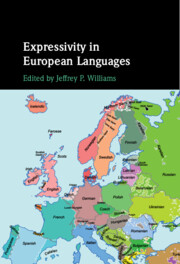Book contents
- Expressivity in European Languages
- Expressivity in European Languages
- Copyright page
- Contents
- Figures
- Tables
- Contributors
- 1 Introduction
- Uralic
- Germanic
- Hellenic
- Romance
- Celtic
- Vasconian
- Caucasian
- Comparative
- 12 Parameters of variation in the syntax of expressive suffixes: Case studies of Russian, German, Spanish and Greek
- Index
- References
12 - Parameters of variation in the syntax of expressive suffixes: Case studies of Russian, German, Spanish and Greek
from Comparative
Published online by Cambridge University Press: 24 August 2023
- Expressivity in European Languages
- Expressivity in European Languages
- Copyright page
- Contents
- Figures
- Tables
- Contributors
- 1 Introduction
- Uralic
- Germanic
- Hellenic
- Romance
- Celtic
- Vasconian
- Caucasian
- Comparative
- 12 Parameters of variation in the syntax of expressive suffixes: Case studies of Russian, German, Spanish and Greek
- Index
- References
Summary
This work compares the morphosyntactic properties of expressive suffixes in four European languages: Russian, German, Spanish and Greek. It shows that although these suffixes share the same expressive meaning, they differ significantly in their syntactic structure, namely in the manner and place of attachment in the syntactic tree. Thus, the Russian and Spanish expressive suffixes that refer to the size of a referent (or size suffixes) are syntactic modifiers, while the German size suffixes are syntactic heads. And in Greek, the two most productive expressive suffixes -ak and -ul have homophonous counterparts that possess contrasting syntactic properties: syntactic heads vs. syntactic modifiers. This shows that across languages as well as within single languages, such as Greek, there is no 1:1 correspondence between the meaning and the structure of expressive forms. These findings are further supported by two novel case studies of the homophonous suffixes -its (in Greek) and -ic (in Russian).
Keywords
- Type
- Chapter
- Information
- Expressivity in European Languages , pp. 361 - 392Publisher: Cambridge University PressPrint publication year: 2023



